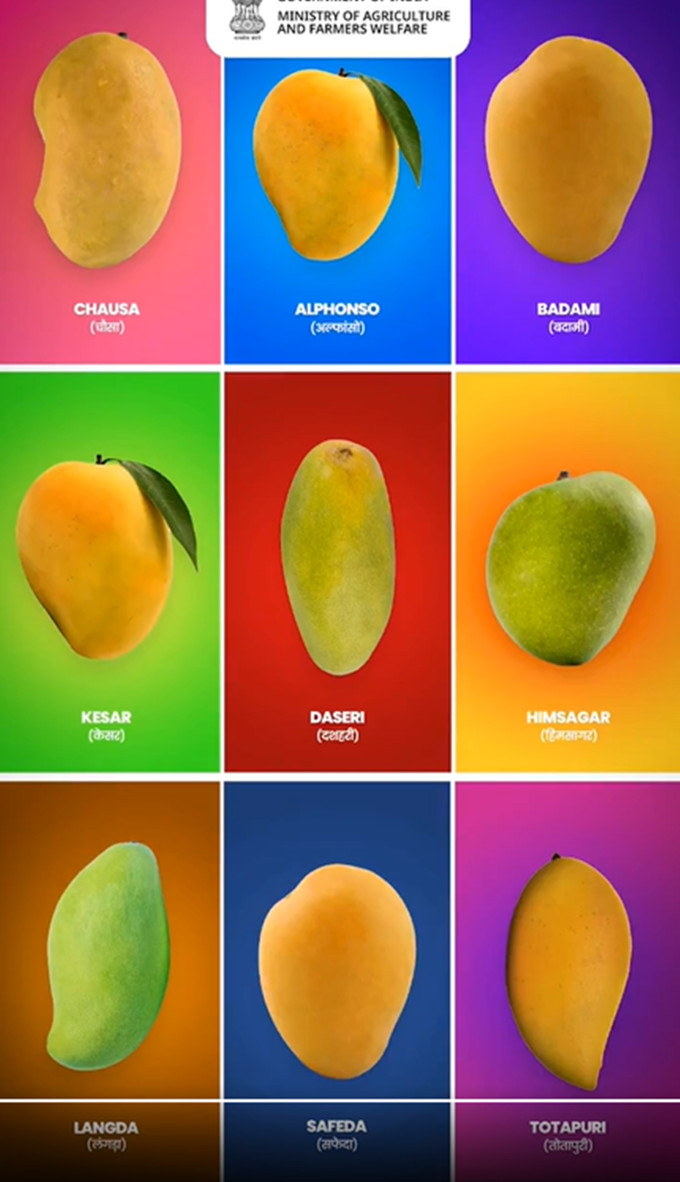From Alphonso to Totapuri: Top 10 mango varieties in India
Come summer, and mango lovers have a reason to rejoice. The juicy fruit, aptly called the king of fruits, is known for its flavour, texture, and taste. Considering this love for mangoes, the Government of India’s Ministry of Agriculture and Farmers Welfare shared the top 10 mango varieties that you can find and relish in India.
“From #Alphonso to #Totapuri, many amazing mango varieties are grown in India. Indian mangoes come in various shapes, sizes, and colours with a wide variety of flavours, aromas, and tastes,” it shared on X, (formerly Twitter). Take a look at the list below:

Chausa
This variety originated as a chance seedling in the orchard of a talukdar of Sandila district Hardoi, Uttar Pradesh, reads UP State Biodiversity Board’s 2012 newsletter. “Fruit large, ovate to oval oblique in shape and light yellow in colour, flesh fibrous; medium keeping quality; extremely sweet; alternate bearing variety; shows apical dominance. It is mostly grown for processing purposes. It is a late-season variety,” it notes.
Alphonso (Happus, Badami)
According to UP State Biodiversity Board‘s newsletter, this variety is known by different names in different regions — Badami, Gundu, Khader, Appas, Happus, and Kagdi Happus. Fruit medium in size, ovate oblique in shape, orange-yellow in colour; the juice is moderate-abundant; excellent keeping quality, good for pulping and canning; mainly exported as fresh fruit to other countries; Flesh develops spongy tissue.
Kesar
This is a leading variety of Gujarat. Fruit medium oblong with a red blush on the shoulders; good keeping quality; ideal for pulping and juice concentrates; early season variety, the newsletter mentioned.
Daseri
The fruit size is small-medium, the shape is elongated with yellow fruit colour, flesh is fibreless; good keeping quality; susceptible to mango malformation. Fruit quality is excellent and keeping quality is good, reads the newsletter.
Himsagar
This variety is indigenous to Bengal. “Fruit is medium-sized ovate fruit with yellow colour; good keeping quality; early season variety,” reads the 2012 newsletter.
Langda
Trees vigorous and spreading; fruit medium, ovate in shape with lettuce green colour; poor keeping quality; skin is very thin and pulp is very sweet. This variety is indigenous to Varanasi area of Uttar Pradesh. It is a mid-season variety.
Safeda
Also known as Chapta, Safeda, Baneshan and Chapai, this fruit is large in size and obliquely oval in shape, notes the UP State Biodiversity Board’s 2011 newsletter. Variety suited for dry areas; fruit large sized, obliquely oval in shape, golden yellow in colour; good keeping quality; good for canning; biennial in habit. It is a mid-season variety
Malgoa
Fruit is large roundish-oblique in shape and yellow in colour; high fruit quality and good keeping quality.
Totapuri
Common synonyms of this variety are Totapuri, Kallamai, Thevadiyamuthi, Collector, Sundersha, Burmodilla, Killi Mukku and Gilli Mukku. Fruits medium-large, oblong shaped with pointed base with golden yellow colour; good keeping quality; used for processing; heavy and regular bearing variety; susceptible to bacterial spot. It is a mid-season variety.
“The Indian mango is a special product that substantiates the high standards of quality and bountiful nutrients packed in it,” shared GOI
Beyond their deliciousness, these varieties are powerhouses of essential nutrients. Mangoes are rich in vitamins A and C, promoting healthy skin, vision, and immune function. “They also contain dietary fibre, aiding digestion and maintaining gut health,” said Sushma PS, chief dietitian, Jindal Naturecure Institute.
 Here are some top mango varieties in India (Source: GOI/Agriculture India/X)
Here are some top mango varieties in India (Source: GOI/Agriculture India/X)
Things to keep in mind when buying and eating mangoes
Sushma shared it’s essential to keep in mind portion control, especially for those watching their sugar intake, as mangoes are naturally high in sugar. “Additionally, selecting ripe, fresh fruits ensures optimal flavour and nutritional value,” said Sushma.
How to choose ripe mangoes?
Lakshita Jain, clinical dietitian and founder, NUTR, Delhi shared in an earlier interaction that ripe mangoes will have a slight give-in when gently pressed, and they’ll also have a sweet fragrance at the stem end.
Know the top 10 mango varieties of India!
From #Alphonso to #Totapuri, many amazing mango varieties are grown in India. Indian mangoes come in various shapes, sizes & colors with a wide variety of flavors, aromas & tastes. #AgriGoI #Mango #MangoYield #agriculture #SummerHealth pic.twitter.com/cl1WhCKl7E
— Agriculture INDIA (@AgriGoI) May 18, 2024
Here’s how to soak mangoes before eating
*Rinse the mangoes under cool water to remove any dirt or debris from the skin.
*Take a bowl large enough to accommodate the mangoes you want to soak and fill it with cool water. Make sure there’s enough water to completely submerge the mangoes.
*Place the mangoes in the bowl of water, ensuring they are fully submerged. You can soak them for anywhere from 15 minutes to an hour, depending on your preference and the ripeness of the mangoes. “Soaking them longer can result in softer flesh and juicier fruit,” said Jain.
*Once soaked, remove the mangoes from the water and pat them dry with a clean kitchen towel or paper towel. Enjoy!
Disclaimer: The copyright of this article belongs to the original author. Reposting this article is solely for the purpose of information dissemination and does not constitute any investment advice. If there is any infringement, please contact us immediately. We will make corrections or deletions as necessary. Thank you.

